Salinity Mitigates the Negative Effect of Elevated Temperatures on Photosynthesis in the C3-C4 Intermediate Species Sedobassia sedoides
Abstract
1. Introduction
2. Results
2.1. Biomass, Water, and Na+ and K+ Content
2.2. CO2/H2O Gas Exchange
2.3. Activity of PSI CET and PSII Efficiency
2.4. Photosynthetic Enzymes Content
2.5. Expression of Photosynthetic Genes
2.6. Lipid Peroxidation and Antioxidant Enzyme Activity
2.7. Enzyme Activity of the Malate Dehydrogenase Complex
2.8. Multifactor Analysis Using Principal Component Analysis (PCA)
3. Discussion
3.1. Effect of Salinity
3.2. Effect of Elevated Temperatures
3.3. Combination of the Effects of Elevated Temperature and Salinity
4. Materials and Methods
4.1. Plant Growth Conditions
4.2. Determination of Water, Na+, and K+ Content
4.3. CO2/H2O Gas Exchange
4.4. Efficiency of PSII Function and Activity of Cyclic Electron Transport (CET) around PSI
4.5. Content of Photosynthetic Enzymes
4.6. RNA Isolation and Quantitative Real Time (RT)-PCR
4.7. Assay of Antioxidant Enzyme Activity and Lipid Peroxidation
4.8. Assay of Malate Dehydrogenase Enzyme Activity
4.9. Statistical Analyses
5. Conclusions
Author Contributions
Funding
Data Availability Statement
Conflicts of Interest
References
- Farooq, M.S.; Uzair, M.; Raza, A.; Habib, M.; Xu, Y.; Yousuf, M.; Yang, S.H.; Ramzan Khan, M. Uncovering the research gaps to alleviate the negative impacts of climate change on food security: A review. Front. Plant Sci. 2022, 13, 927535. [Google Scholar] [CrossRef] [PubMed]
- Pandey, P.; Ramegowda, V.; Senthil-Kumar, M. Shared and unique responses of plants to multiple individual stresses and stress combinations: Physiological and molecular mechanisms. Front. Plant Sci. 2015, 6, 723. [Google Scholar] [CrossRef] [PubMed]
- Rivero, R.M.; Mestre, T.C.; Mittler, R.O.; Rubio, F.; Garcia-Sanchez, F.; Martinez, V. The combined effect of salinity and heat reveals a specific physiological, biochemical and molecular response in tomato plants. Plant Cell Environ. 2014, 37, 1059–1073. [Google Scholar] [CrossRef] [PubMed]
- Allakhverdiev, S.I.; Kreslavski, V.D.; Fomina, I.R.; Los, D.A.; Klimov, V.V.; Mimuro, M.; Mohanty, P.; Carpentier, R. Inactivation and repair of photosynthetic machinery under heat stress. In Photosynthesis: Overviews on Recent Progress and Future Perspective; IK International Publishing House Pvt. Ltd.: New Delhi, India, 2012; p. 189. [Google Scholar]
- Yamori, W.; Shikanai, T. Physiological functions of cyclic electron transport around photosystem I in sustaining photosynthesis and plant growth. Annu. Rev. Plant Biol. 2016, 67, 81–106. [Google Scholar] [CrossRef] [PubMed]
- Kramer, D.M.; Evans, J.R. The importance of energy balance in improving photosynthetic productivity. Plant Physiol. 2011, 155, 70–78. [Google Scholar] [CrossRef] [PubMed]
- Chadee, A.; Alber, N.A.; Dahal, K.; Vanlerberghe, G.C. The complementary roles of chloroplast cyclic electron transport and mitochondrial alternative oxidase to ensure photosynthetic performance. Front. Plant Sci. 2021, 12, 748204. [Google Scholar] [CrossRef]
- Wobbe, L.; Bassi, R.; Kruse, O. Multi-level light capture control in plants and green algae. Trends Plant Sci. 2016, 21, 55–68. [Google Scholar] [CrossRef]
- Murchie, E.H.; Ruban, A.V. Dynamic non-photochemical quenching in plants: From molecular mechanism to productivity. Plant J. 2020, 101, 885–896. [Google Scholar] [CrossRef]
- Wang, C.; Yamamoto, H.; Shikanai, T. Role of cyclic electron transport around photosystem I in regulating proton motive force. Biochim. Biophys. Acta 2015, 1847, 931–938. [Google Scholar] [CrossRef]
- Nakano, H.; Yamamoto, H.; Shikanai, T. Contribution of NDH-dependent cyclic electron transport around photosystem I to the generation of proton motive force in the weak mutant allele of pgr5. Biochim. Biophys. Acta 2019, 1860, 369–374. [Google Scholar] [CrossRef] [PubMed]
- Munekage, Y.; Hashimoto, M.; Miyake, C.; Tomizawa, K.I.; Endo, T.; Tasaka, M.; Shikanai, T. Cyclic electron flow around photosystem I is essential for photosynthesis. Nature 2004, 429, 579–582. [Google Scholar] [CrossRef]
- Ma, M.; Liu, Y.; Bai, C.; Yang, Y.; Sun, Z.; Liu, X.; Zhang, S.; Han, X.; Yong, J.W.H. The physiological functionality of PGR5/PGRL1-dependent cyclic electron transport in sustaining photosynthesis. Front. Plant Sci. 2021, 12, 702196. [Google Scholar] [CrossRef] [PubMed]
- Fisher, N.; Bricker, T.M.; Kramer, D.M. Regulation of photosynthetic cyclic electron flow by adenylate status in higher plant chloroplasts. BBA-Bioenergetics 2019, 1860, 148081. [Google Scholar] [CrossRef] [PubMed]
- Selinski, J.; Scheibe, R. Malate valves: Old shuttles with new perspectives. Plant Biol. 2018, 21, 21–30. [Google Scholar] [CrossRef] [PubMed]
- Taniguchi, M.; Miyake, H. Redox-shuttling between chloroplast and cytosol: Integration of intra-chloroplast and extra-chloroplast metabolism. Curr. Opin. Plant Biol. 2012, 15, 252–260. [Google Scholar] [CrossRef] [PubMed]
- Walker, B.J.; Kramer, D.M.; Fisher, N.; Fu, X. Flexibility in the energy balancing network of photosynthesis enables safe operation under changing environmental conditions. Plants 2020, 9, 301. [Google Scholar] [CrossRef] [PubMed]
- Munns, R.; Tester, M. Mechanisms of salinity tolerance. Annu. Rev. Plant Biol. 2008, 59, 651–681. [Google Scholar] [CrossRef]
- Pan, T.; Liu, M.; Kreslavski, V.D.; Zharmukhamedov, S.K.; Nie, C.; Yu, M.; Kuznetsov, V.V.; Allakhverdiev, S.I.; Shabala, S. Non-stomatal limitation of photosynthesis by soil salinity. Crit. Rev. Environ. Sci. Technol. 2021, 51, 791–825. [Google Scholar] [CrossRef]
- Bose, J.; Munns, R.; Shabala, S.; Gilliham, M.; Pogson, B.; Tyerman, S.D. Chloroplast function and ion regulation in plants growing on saline soils: Lessons from halophytes. J. Exp. Bot. 2017, 68, 3129–3143. [Google Scholar] [CrossRef]
- Bose, J.; Rodrigo-Moreno, A.; Shabala, S. ROS homeostasis in halophytes in the context of salinity stress tolerance. J. Exp. Bot. 2014, 65, 1241–1257. [Google Scholar] [CrossRef]
- Percey, W.J.; Shabala, L.; Breadmore, M.C.; Guijt, R.M.; Bose, J.; Shabala, S. Ion transport in broad bean leaf mesophyll under saline conditions. Planta 2014, 240, 729–743. [Google Scholar] [CrossRef]
- Ozgur, R.; Uzilday, B.; Sekmen, A.H.; Turkan, I. Reactive oxygen species regulation and antioxidant defence in halophytes. Funct. Plant Biol. 2013, 40, 832–847. [Google Scholar] [CrossRef]
- Isayenkov, S.V.; Maathuis, F.J.M. Plant salinity stress: Many unanswered questions remain. Front. Plant Sci. 2019, 10, 80. [Google Scholar] [CrossRef]
- Zelm, E.; Zhang, Y.; Testerink, C. Salt tolerance mechanisms of plants. Annu. Rev. Plant Biol. 2020, 71, 403–433. [Google Scholar] [CrossRef]
- Lamers, J.; Meer, T.; Testerink, C. How plants sense and respond to stressful environments. Plant Physiol. 2020, 182, 1624–1635. [Google Scholar] [CrossRef] [PubMed]
- Chen, X.; Ding, Y.; Yang, Y.; Song, C.H.; Wang, B.; Yang, S.H.; Guo, Y.; Gong, Z. Protein kinases in plant responses to drought, salt, and cold stress. J. Integr. Plant Biol. 2021, 63, 53–78. [Google Scholar] [CrossRef] [PubMed]
- Voznesenskaya, E.V.; Koteyeva, N.K.; Akhani, H.; Roalson, E.H.; Edwards, G.E. Structural and physiological analyses in Salsoleae (Chenopodiaceae) indicate multiple transitions among C3, intermediate, and C4 photosynthesis. J. Exp. Bot. 2013, 64, 3583. [Google Scholar] [CrossRef]
- Khoshravesh, R.; Stinson, C.R.; Stata, M.; Busch, F.A.; Sage, R.F.; Ludwig, M.; Sage, T.L. C3–C4 intermediacy in grasses: Organelle enrichment and distribution, glycine decarboxylase expression, and the rise of C2 photosynthesis. J. Exp. Bot. 2016, 67, 3065–3078. [Google Scholar] [CrossRef]
- Schlüter, U.; Weber, A.P.M. Regulation and Evolution of C 4 Photosynthesis. Annu. Rev. Plant Biol. 2020, 71, 183–215. [Google Scholar] [CrossRef] [PubMed]
- Walsh, C.A.; Bräutigam, A.; Roberts, M.R.; Lundgren, M.R. Evolutionary implications of C2 photosynthesis: How complex biochemical trade-offs may limit C4 evolution. J. Exp. Bot. 2023, 74, 707–722. [Google Scholar] [CrossRef] [PubMed]
- Shuyskaya, E.; Rakhmankulova, Z.; Voronin, P.; Kuznetsova, N.; Biktimerova, G.; Usmanov, I. Salt and osmotic stress tolerance of the C3-C4 xero-halophyte Bassia sedoides from two populations differ in productivity and genetic polymorphism. Acta Physiol. Plantarum. 2015, 37, 236. [Google Scholar] [CrossRef]
- Rakhmankulova, Z.F.; Shuyskaya, E.V.; Suyundukov, Y.T.; Usmanov, I.Y.; Voronin, P.Y. Different responses of two ecotypes of C3-C4 xero-halophyte Bassia sedoides to osmotic and ionic factors of salt stress. Russ. J. Plant Physiol. 2016, 63, 349–357. [Google Scholar] [CrossRef]
- Rakhmankulova, Z.F.; Shuyskaya, E.V.; Khalilova, L.A.; Burundukova, O.L.; Velivetskaya, T.A.; Ignat’ev, A.V.; Orlova, Y.V. Ultra- and Mesostructural Response to Salinization in Two Populations of C3–C4 Intermediate Species Sedobassia sedoides. Russ. J. Plant Physiol. 2020, 67, 835–844. [Google Scholar] [CrossRef]
- Shavrukov, Y. Salt stress or salt shock: Which genes are we studying? J. Exp. Bot. 2013, 64, 119–127. [Google Scholar] [CrossRef]
- Rakhmankulova, Z.F.; Shuyskaya, E.V.; Shcherbakov, A.V.; Fedyaev, V.V.; Biktimerova, G.Y.; Khafisova, R.R.; Usmanov, I.Y. Content of Proline and Flavonoids in the Shoots of Halophytes Inhabiting the South Urals. Russ. J. Plant Physiol. 2015, 62, 71–79. [Google Scholar] [CrossRef]
- Yamori, W.; Sakata, N.; Suzuki, Y. Cyclic electron flow around photosystem I via chloroplast NAD(P)H dehydrogenase (NDH) complex performs a significant physiological role during photosynthesis and plant growth at low temperature in rice. Plant J. 2011, 68, 966–976. [Google Scholar] [CrossRef]
- Cerqueira, J.V.A.; Silveira, J.A.G.; Carvalho, F.E.L.; Cunha, J.R.; Neto, M.C.L. The regulation of P700 is an important photoprotective mechanism to NaCl-salinity in Jatropha curcas. Physiol. Plant. 2019, 167, 404–417. [Google Scholar] [CrossRef]
- Asada, K. The water-water cycle as alternative photon and electron sinks. Philos. Trans. R. Soc. Lond. B Biol. Sci. 2000, 355, 1419–1431. [Google Scholar] [CrossRef]
- Nakamura, N.; Iwano, M.; Havaux, M.; Yokota, A.; Munekage, Y.N. Promotion of cyclic electron transport around photosystem I during the evolution of NADP-malic enzyme-type c photosynthesis in the genus Flaveria. New Phytol. 2013, 199, 832–842. [Google Scholar] [CrossRef]
- Nunes-Nesi, A.; Araújo, W.L.; Obata, T.; Fernie, A.R. Regulation of the mitochondrial tricarboxylic acid cycle. Curr. Opin. Plant Biol. 2013, 16, 335–343. [Google Scholar] [CrossRef]
- He, Y.; Yu, C.; Zhou, L.; Chen, Y.; Liu, A.; Jin, J.; Hong, J.; Qi, Y.; Jiang, D. Rubisco decrease is involved in chloroplast protrusion and Rubisco-containing body formation in soybean (Glycine max.) under salt stress. Plant Physiol. Biochem. 2014, 74, 118–124. [Google Scholar] [CrossRef]
- Yoshitake, Y.; Nakamura, S.; Shinozaki, D.; Izumi, M.; Yoshimoto, K.; Ohta, H.; Shimojima, M. RCB-mediated chlorophagy caused by oversupply of nitrogen suppresses phosphate-starvation stress in plants. Plant Physiol. 2021, 185, 318–330. [Google Scholar] [CrossRef]
- Kusnetsov, V.V. Chloroplasts: Structure and Expression of the Plastid Genome. Russ. J. Plant Physiol. 2018, 65, 465–476. [Google Scholar] [CrossRef]
- Vauclare, P.; Diallo, N.; Bourguingnon, J.; Macherei, D.; Douce, R. Regulation of the expression of the glycine decarboxylase complex during pea leaf development. Plant Physiol. 1996, 112, 1523–1530. [Google Scholar] [CrossRef][Green Version]
- Douce, R.; Bourguignon, J.; Neuburger, M.; Rébeillé, F. The glycine decarboxylase system: A fascinating complex. Trends Plant Sci. 2001, 6, 167–176. [Google Scholar] [CrossRef]
- Hasanuzzaman, M.; Bhuyan, M.H.M.B.; Zulfiqar, F.; Raza, A.; Mohsin, S.M.; Al Mahmud, J.; Fujita, M.; Fotopoulos, V. Reactive Oxygen Species and Antioxidant Defense in Plants under Abiotic Stress: Revisiting the Crucial Role of a Universal Defense Regulator. Antioxidants 2020, 9, 681. [Google Scholar] [CrossRef]
- Fortunato, S.; Lasorella, C.; Dipierro, N.; Vita, F.; de Pinto, M.C. Redox Signaling in Plant Heat Stress Response. Antioxidants 2023, 12, 605. [Google Scholar] [CrossRef]
- Lu, C.; Qiu, N.; Wang, B.; Zhang, J. Salinity treatment shows no effects on photosystem II photochemistry, but increases the resistance of photosystem II to heat stress in halophyte Suaeda salsa. J. Exp. Bot. 2003, 54, 851–860. [Google Scholar] [CrossRef] [PubMed]
- Nishiyama, Y.; Allakhverdiev, S.I.; Murata, N. Protein synthesis is the primary target of reactive oxygen species in the photoinhibition of photosystem II. Physiol Plant. 2011, 142, 35–46. [Google Scholar] [CrossRef] [PubMed]
- Atkin, O.K.; Bruhn, D.; Hurry, V.M.; Tjoelker, M. The hot and the cold: Unravelling the variable response of plant respiration to temperature. Funct. Plant Biol. 2005, 32, 87–105. [Google Scholar] [CrossRef] [PubMed]
- Li, G.; Chen, T.; Feng, B.; Peng, S.; Tao, L.; Fu, G. Respiration, rather than photosynthesis, determines rice yield loss under moderate high-temperature conditions. Front. Plant Sci. 2021, 12, 678653. [Google Scholar] [CrossRef] [PubMed]
- Jacoby, R.P.; Taylor, N.L.; Millar, A.H. The role of mitochondrial respiration in salinity tolerance. Trends Plant Sci. 2011, 16, 614–623. [Google Scholar] [CrossRef] [PubMed]
- Perera, L.K.R.R.; Mansfield, T.A.; Malloch, A.J.C. Stomatal responses to sodium ions in Aster tripolium: A new hypothesis to explain salinity regulation in above-ground tissues. Plant Cell Environ. 1994, 17, 335–340. [Google Scholar] [CrossRef]
- Shabala, S.; Mackay, A. Ion transport in halophytes. Adv. Bot. Res. 2011, 57, 151–199. [Google Scholar] [CrossRef]
- Chen, Q.; Wang, B.; Ding, H.; Zhang, J.; Li, S. The role of NADP-malic enzyme in plants under stress. Plant Sci. 2019, 281, 206–212. [Google Scholar] [CrossRef]
- Qiu, N.; Lu, C. Enhanced tolerance of photosynthesis against high temperature damage in salt-adapted halophyte Atriplex centralasiatica plants. Plant Cell Environ. 2003, 26, 1137–1145. [Google Scholar] [CrossRef]
- Rodrigues, F.; Sousa, B.; Soares, C.; Moreira, D.; Pereira, C.; Moutinho-Pereira, J.; Fidalgo, F. Are tomato plants co-exposed to heat and salinity able to ensure a proper carbon metabolism?—An insight into the photosynthetic hub. Plant Physiol. Biochem. 2024, 206, 108270. [Google Scholar] [CrossRef]
- Silva, E.N.; Vieira, S.A.; Ribeiro, R.V.; Ponte, L.F.; Ferreira-Silva, S.L.; Silveira, J.A. Contrasting physiological responses of Jatropha curcas plants to single and combined stresses of salinity and heat. J. Plant Growth Regul. 2013, 32, 159–169. [Google Scholar] [CrossRef]
- Lin, Y.H.; Pan, K.Y.; Hung, C.H.; Huang, H.E.; Chen, C.L.; Feng, T.Y.; Huang, L.-F. Overexpression of ferredoxin, PETF, enhances tolerance to heat stress in Chlamydomonas reinhardtii. Int. J. Mol. Sci. 2013, 14, 20913–20929. [Google Scholar] [CrossRef]
- Lin, Y.H.; Huang, L.F.; Hase, T.; Huang, H.E.; Feng, T.Y. Expression of plant ferredoxin-like protein (PFLP) enhances tolerance to heat stress in Arabidopsis thaliana. New Biotechnol. 2015, 32, 235–242. [Google Scholar] [CrossRef]
- Shuyskaya, E.; Rakhmankulova, Z.; Prokofieva, M.; Kazantseva, V.; Lunkova, N. Impact of salinity, elevated temperature, and their Interaction with the photosynthetic efficiency of halophyte crop Chenopodium quinoa Willd. Agriculture 2023, 13, 1198. [Google Scholar] [CrossRef]
- Rakhmankulova, Z.F.; Shuyskaya, E.V.; Prokofieva, M.Y.; Toderich, K.N.; Yamanaka, N.; Voronin, P.Y. The effect of elevated temperature on salt tolerance mechanism in C4 xero-halophyte Kochia prostrata. Russ. J. Plant Physiol. 2022, 69, 137. [Google Scholar] [CrossRef]
- Doubnerová, V.; Ryšlavá, H. What can enzymes of C(4) photosynthesis do for C(3) plants under stress. Plant Sci. 2011, 180, 575–583. [Google Scholar] [CrossRef] [PubMed]
- Shuyskaya, E.; Rakhmankulova, Z.; Prokofieva, M.; Saidova, L.; Toderich, K.; Voronin, P. Intensity and duration of salinity required to form adaptive response in C4 halophyte Kochia prostrata (L.) Shrad. Front. Plant Sci. 2022, 13, 955880. [Google Scholar] [CrossRef]
- Klughammer, C.; Schreiber, U. Measuring P700 absorbance changes in the near infrared spectral region with a dual wavelength pulse modulation system. In Photosynthesis: Mechanisms and Effects; Garab, G., Ed.; Kluwer Academic Publishers: Dordrecht, The Netherlands, 1998; p. 4357. [Google Scholar] [CrossRef]
- Schreiber, U. Chlorophyll Fluorescence and Photosynthetic Energy Conversion: Simple Introductory Experiments with the TEACHING-PAM Chlorophyll Fluorometer; Heinz Walz GmbH: Effeltrich, Germany, 1997. [Google Scholar]
- Shuyskaya, E.V.; Rakhmankulova, Z.F.; Prokofieva, M.Y.; Kazantseva, V.V.; Lunkova, N.F.; Saidova, L.T. Effect of acclimation to high temperatures on the mechanisms of drought tolerance in species with different types of photosynthesis: Sedobassia sedoides (C3–C4) and Bassia prostrata (C4-NADP). Russ. J. Plant Physiol. 2023, 70, 127. [Google Scholar] [CrossRef]
- Beauchamp, C.; Fridovich, I. Superoxide dismutase: Improved assays and an assay applicable to acrylamide gels. Anal. Biochem. 1971, 44, 276–287. [Google Scholar] [CrossRef]
- Shevyakova, N.I.; Stetsenko, L.A.; Meshcheryakov, A.B.; Kuznetsov, V.V. The activity of the peroxidase system in the courseof stress-induced CAM development. Russ. J. Plant Physiol. 2002, 49, 598–604. [Google Scholar] [CrossRef]
- Aebi, H. Catalase in vitro. Methods Enzymol. 1984, 105, 121–126. [Google Scholar] [CrossRef] [PubMed]
- Heath, R.L.; Packer, L. Photoperoxidation in isolated chloroplasts. Arch. Biochem. Biophys. 1968, 125, 180–198. [Google Scholar] [CrossRef]
- Eprintsev, A.T.; Fedorina, O.S. Functioning of malate dehydrogenase system in mesophyll and bundle sheath cells of maize leaves under salt stress conditions. Russ. J. Plant Physiol. 2007, 54, 728–735. [Google Scholar] [CrossRef]
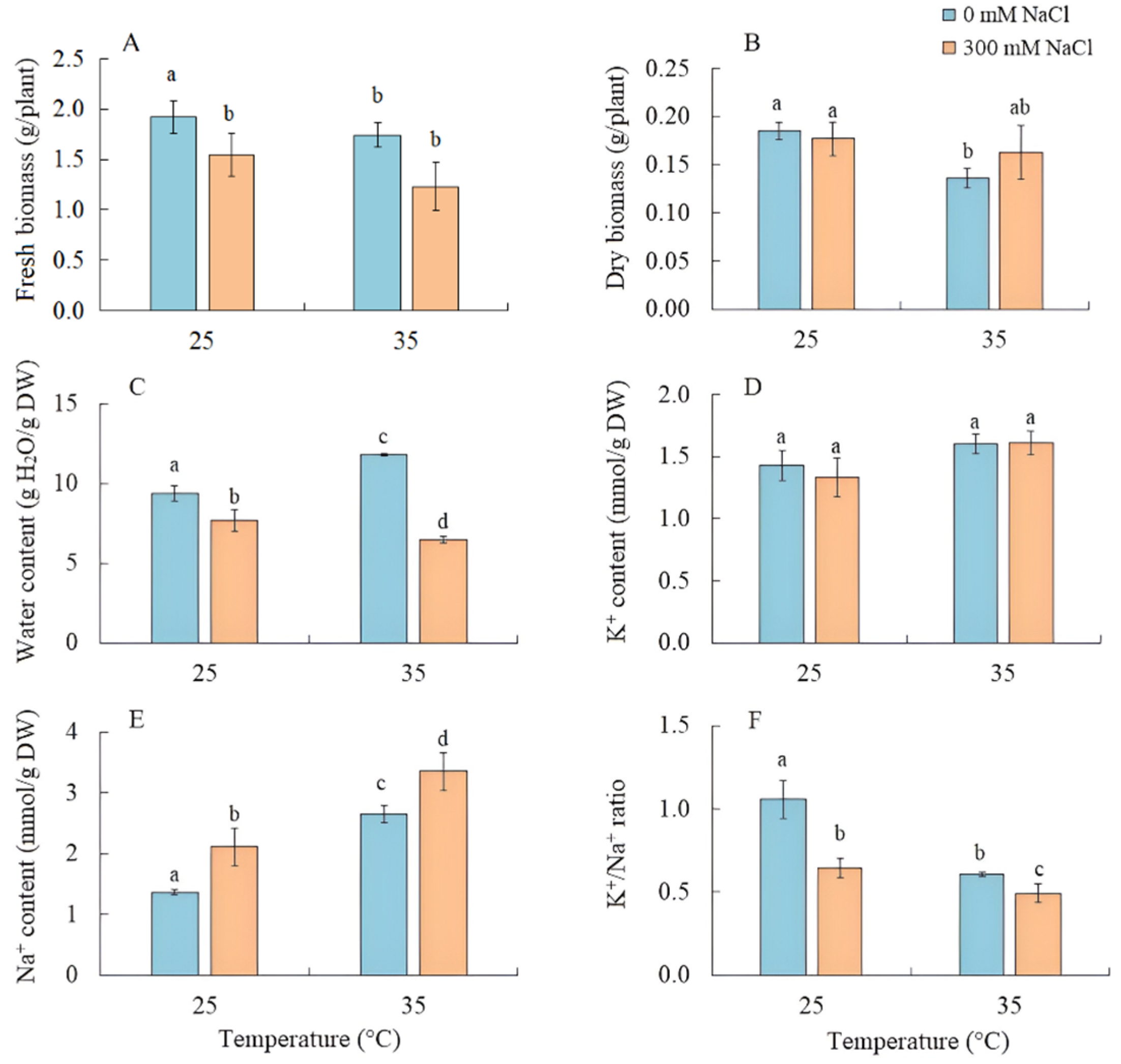


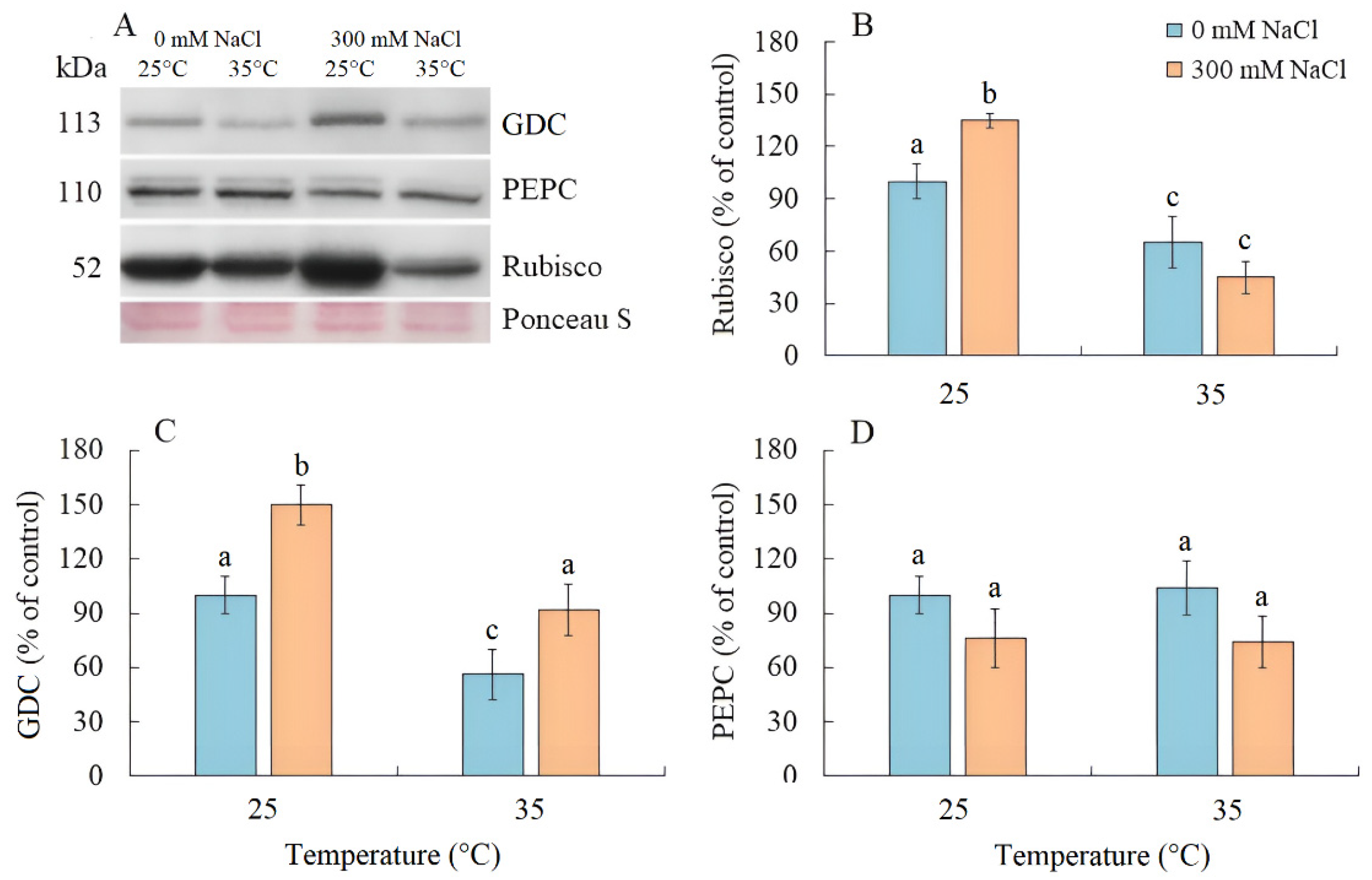
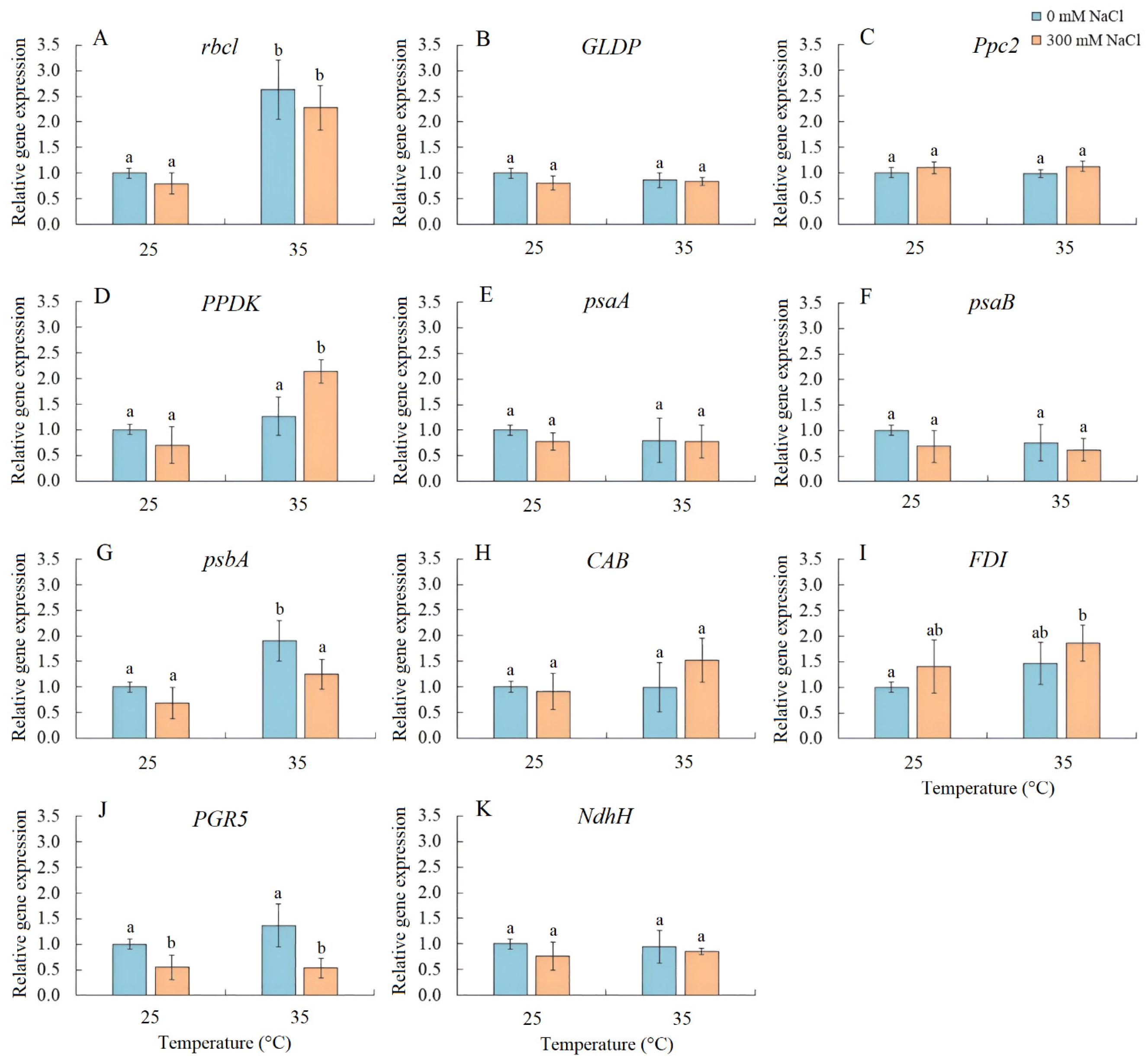
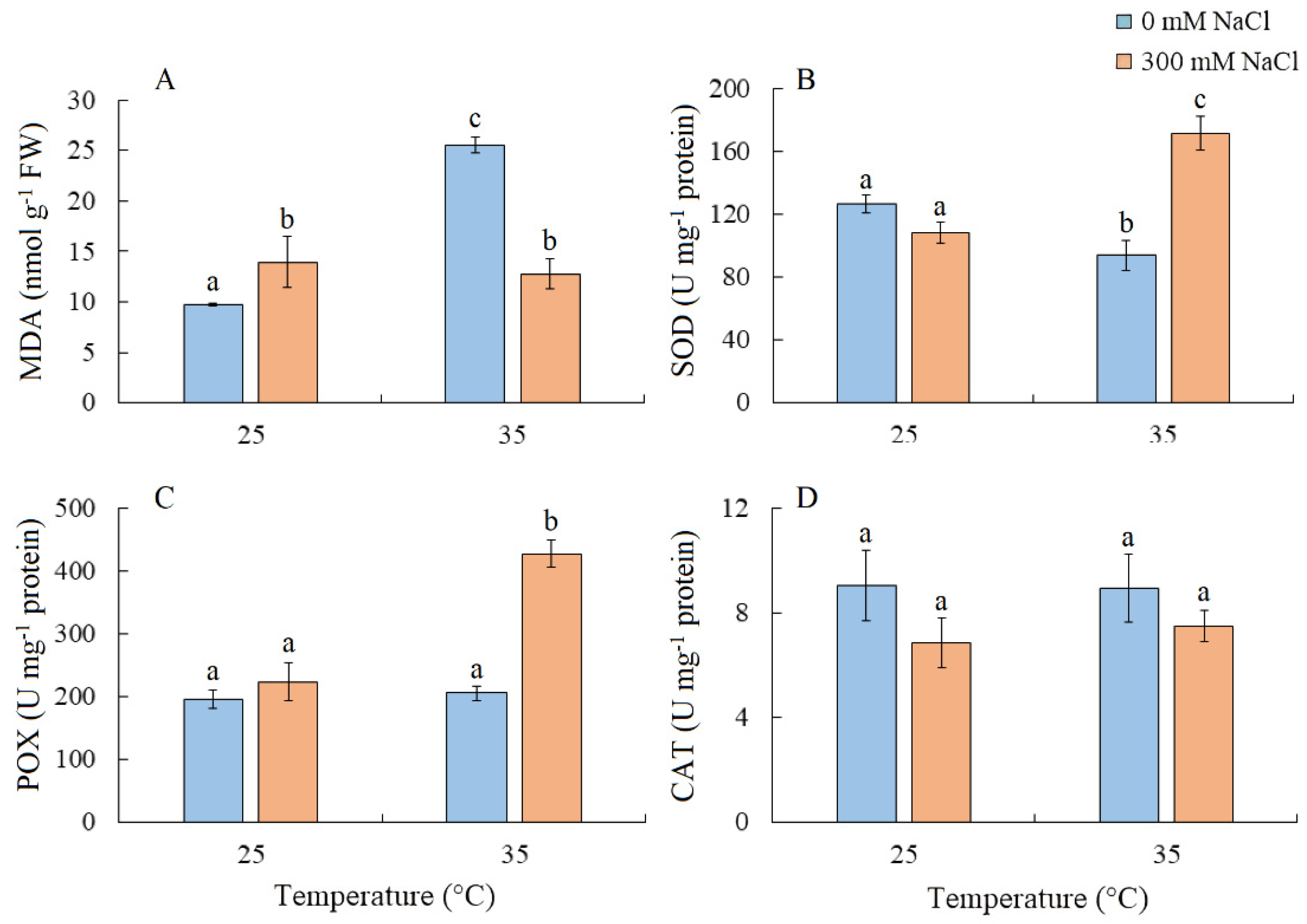
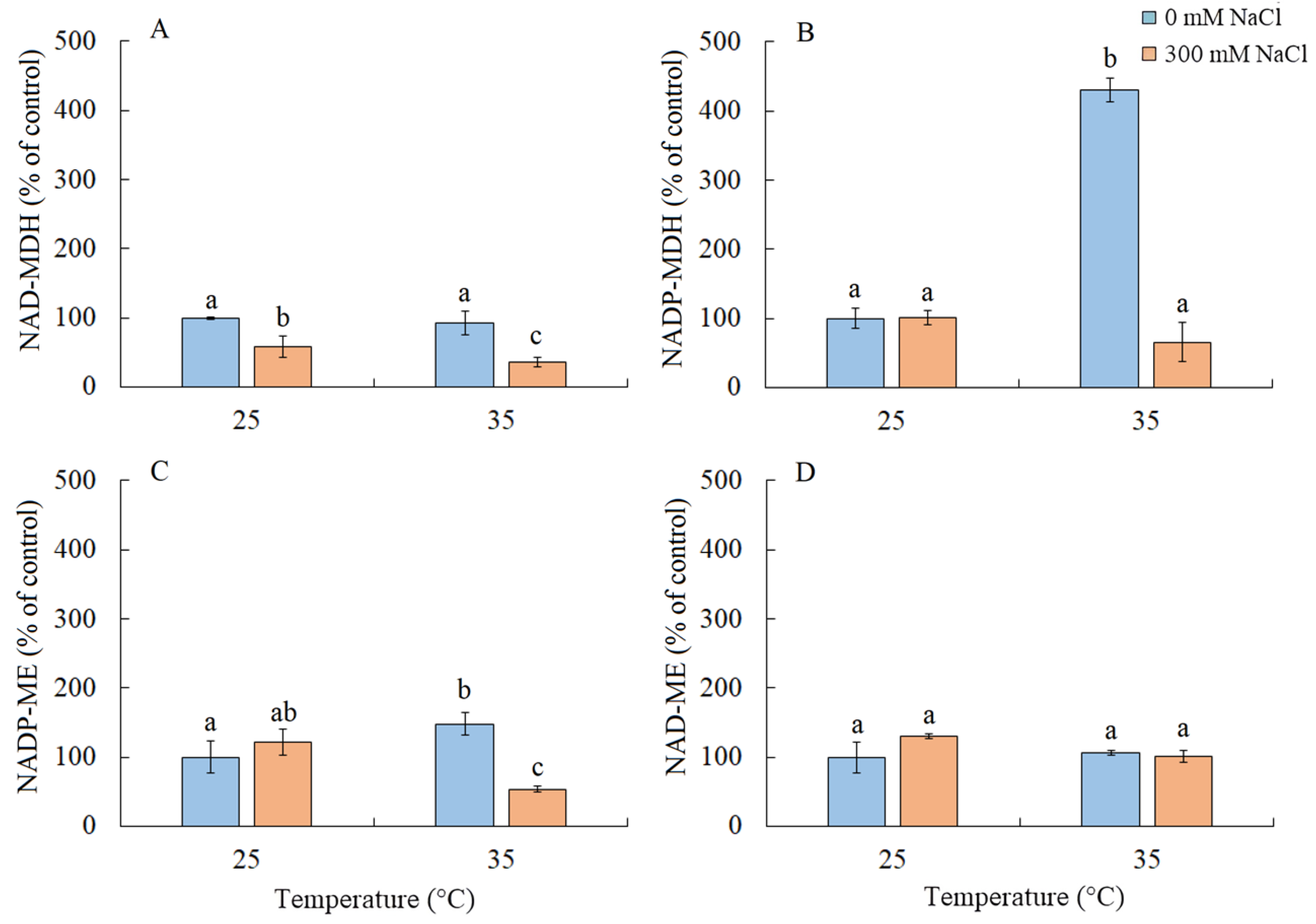
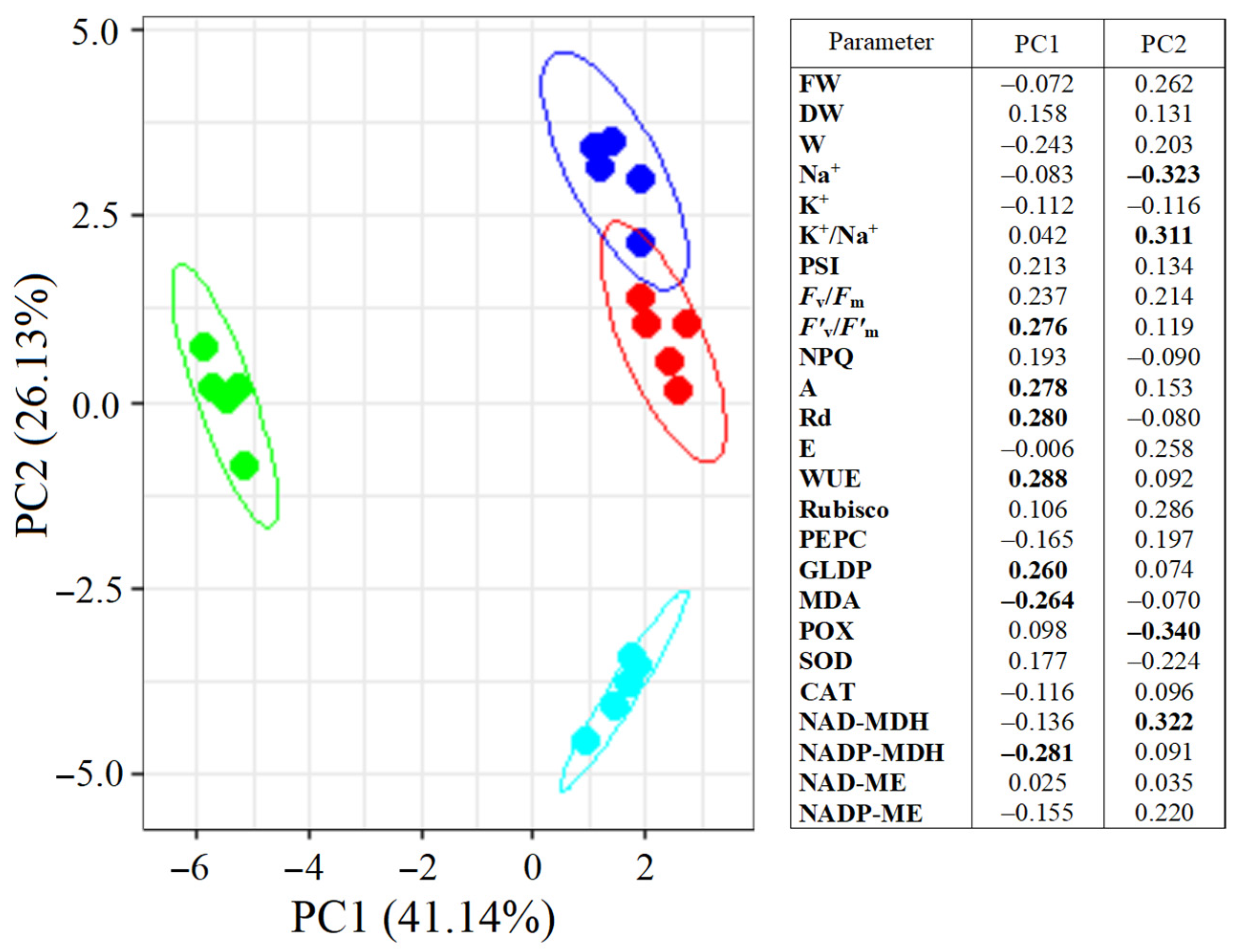
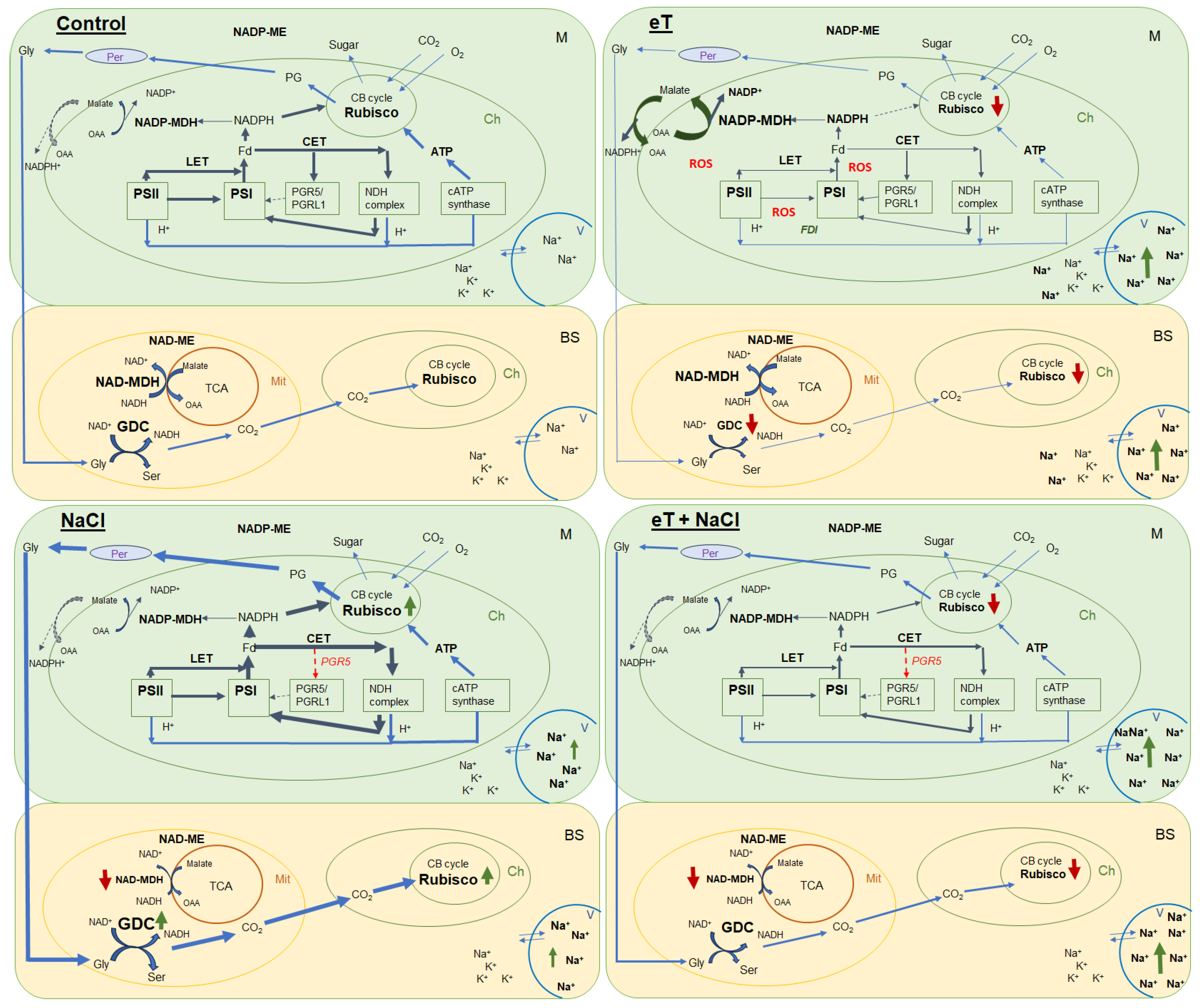
| Primer | Gene | Function | 5′–3′ Sequence |
|---|---|---|---|
| rbcL | AY270063.1 | Large subunit (L) Rubisco | AGGCAAGCTTGAAGGGGAAA CTCCTGAAGCAACAGGCAGA |
| Ppc2 | LOC110737782 | PEPC isoform 2 | GGAGGTGGACCTACCCATCT CTCAAGAGTGGCAGCAGTGA |
| GLDP | LOC110705444 | P subunit GDC | TGTGGTTGATTTCAGCGCGT CGGCAACTAAGCCAGAAGGT |
| PPDK | MK674493.1 | Pyruvate phosphate dikinase | GGTAAGGAATGAAACTAGCCCAGAGG GATCTCAGAGCACCCTGAAACACAAC |
| psaA | OK539756.1 | Apoprotein A1 of photosystem I | CCGCGCCCGCTAAATAAAAA AATGGGTGGCTCCGTGATTT |
| psaB | LOC32958940 | Apoprotein A2 of photosystem I | GAACCGCGTGCATCTAAAGC GCCTGGCTGGTTAAATGCTG |
| psbA | AY251266.1 | Protein D1 of photosystem II | CAGGCTGAGCACAACATCCT AATAGGGAGCCGCCGAATAC |
| FDI | LOC110699227 | Ferredoxin I protein | GAGTTTGAGTGCCCGGATGA CTGGTCGAGAGTACCAGACG |
| PGR5 | LOC110692940 | PGR5 protein, a key part of the main CET pathway of PSI | TCACAACCACAAGAGGAGCAA TCGCGTCCGGTGAGAATTAC |
| NdhH | LOC32959000 | 49 kDa subunit of the NADH dehydrogenase in the second CET pathway of PSI | GGCCATTTCACCGATTCGTA GGCCCTATGCTACGAGCTTC |
| CAB | LOC110735177 | Chlorophyll a/b-binding protein LHCB/CAB PS II | TTCCAGGAGGTCAAGCAACC AGCTCCACCAGGGTACTTCT |
| UBQ10 | LOC110721034 | Ubiquitin 10 (reference gene) | CTTGTCCTTCGTCTCCGTGG CGCCATATACTTCACGCCGA |
| b-Tubulin | XM_021890176 | b-tubulin (reference gene) | ACCGGAGAAGGTATGGACGA GTACTCTTCCTCATCGGCGG |
Disclaimer/Publisher’s Note: The statements, opinions and data contained in all publications are solely those of the individual author(s) and contributor(s) and not of MDPI and/or the editor(s). MDPI and/or the editor(s) disclaim responsibility for any injury to people or property resulting from any ideas, methods, instructions or products referred to in the content. |
© 2024 by the authors. Licensee MDPI, Basel, Switzerland. This article is an open access article distributed under the terms and conditions of the Creative Commons Attribution (CC BY) license (https://creativecommons.org/licenses/by/4.0/).
Share and Cite
Shuyskaya, E.; Rakhmankulova, Z.; Prokofieva, M.; Lunkova, N.; Voronin, P. Salinity Mitigates the Negative Effect of Elevated Temperatures on Photosynthesis in the C3-C4 Intermediate Species Sedobassia sedoides. Plants 2024, 13, 800. https://doi.org/10.3390/plants13060800
Shuyskaya E, Rakhmankulova Z, Prokofieva M, Lunkova N, Voronin P. Salinity Mitigates the Negative Effect of Elevated Temperatures on Photosynthesis in the C3-C4 Intermediate Species Sedobassia sedoides. Plants. 2024; 13(6):800. https://doi.org/10.3390/plants13060800
Chicago/Turabian StyleShuyskaya, Elena, Zulfira Rakhmankulova, Maria Prokofieva, Nina Lunkova, and Pavel Voronin. 2024. "Salinity Mitigates the Negative Effect of Elevated Temperatures on Photosynthesis in the C3-C4 Intermediate Species Sedobassia sedoides" Plants 13, no. 6: 800. https://doi.org/10.3390/plants13060800
APA StyleShuyskaya, E., Rakhmankulova, Z., Prokofieva, M., Lunkova, N., & Voronin, P. (2024). Salinity Mitigates the Negative Effect of Elevated Temperatures on Photosynthesis in the C3-C4 Intermediate Species Sedobassia sedoides. Plants, 13(6), 800. https://doi.org/10.3390/plants13060800








